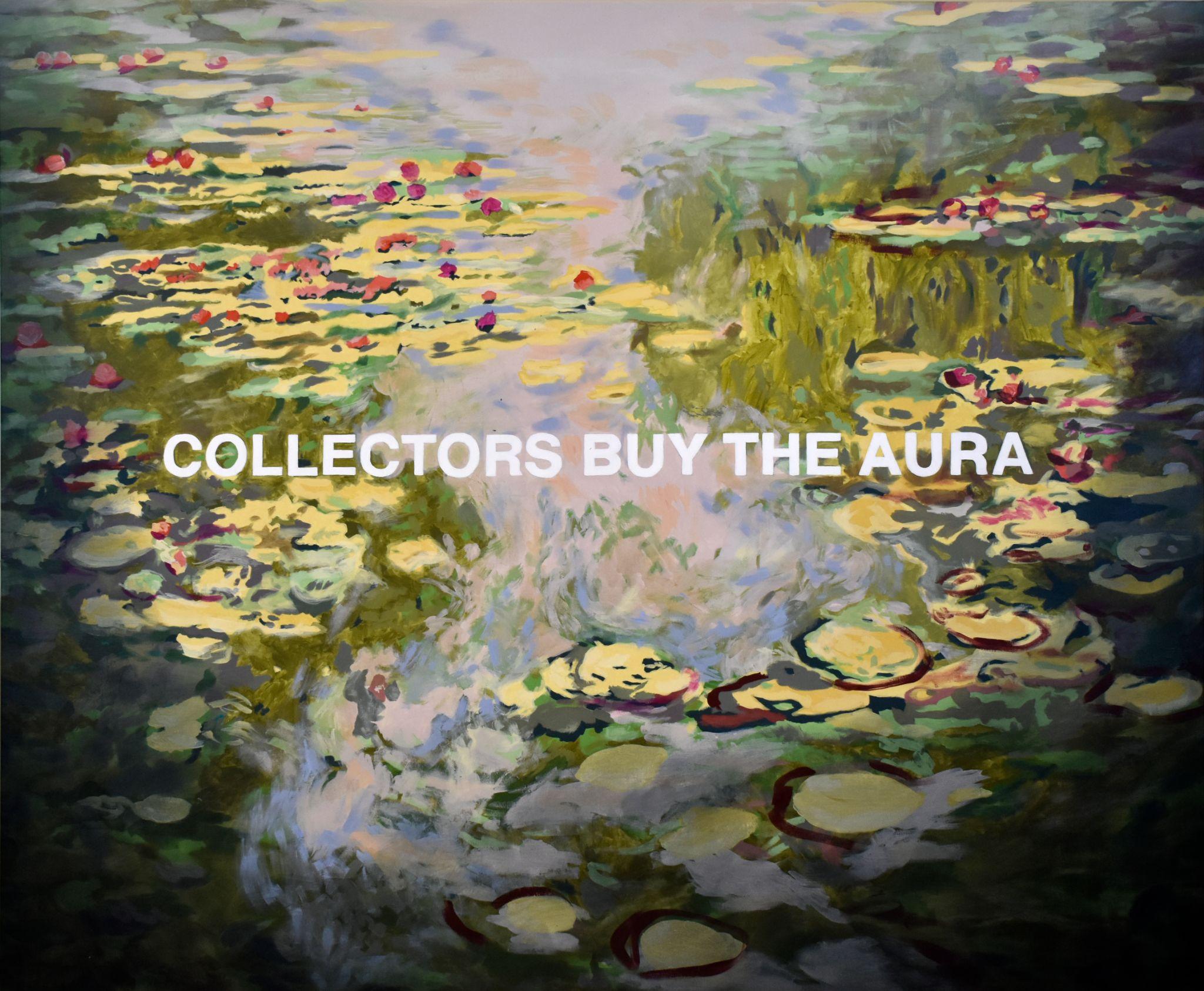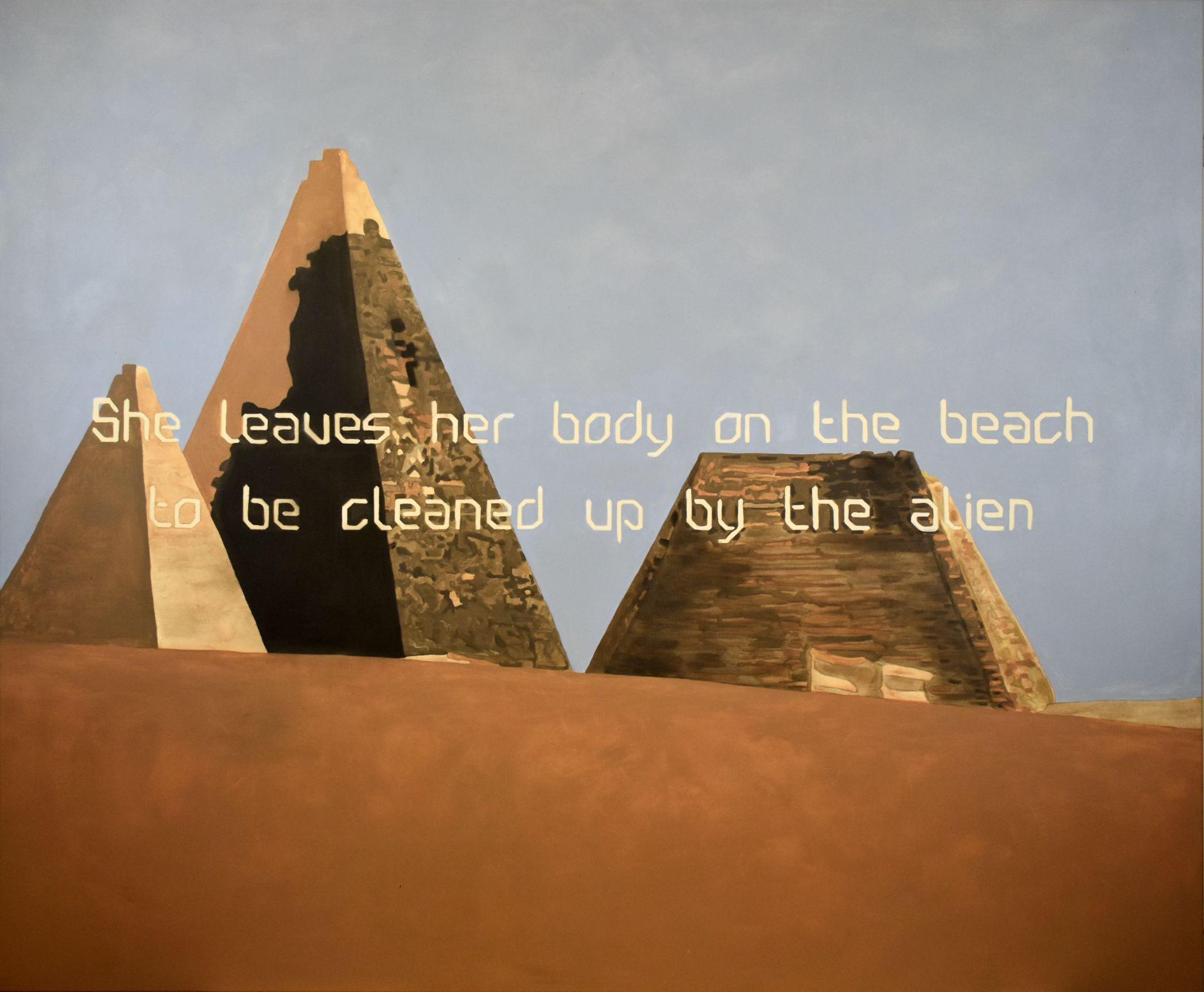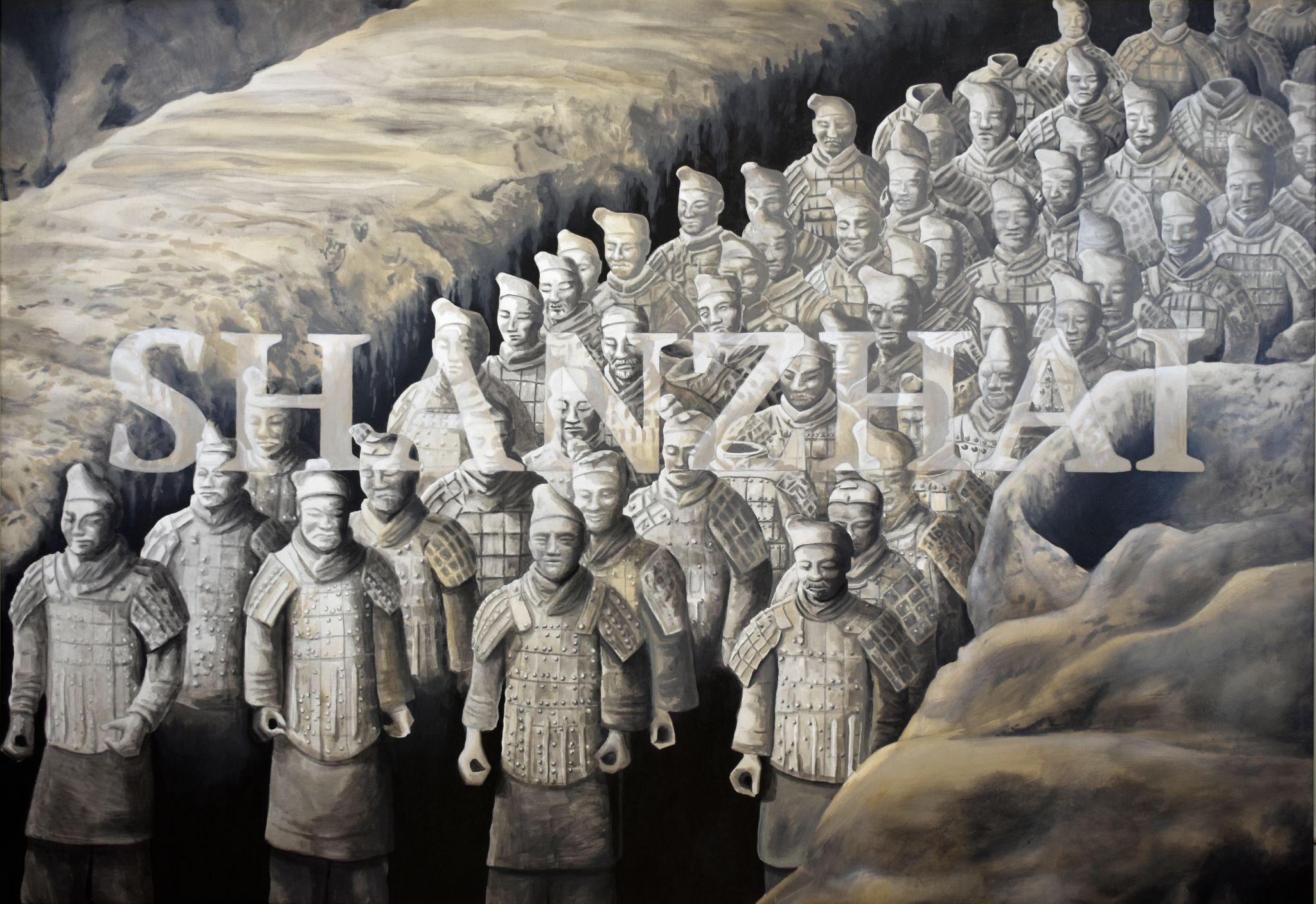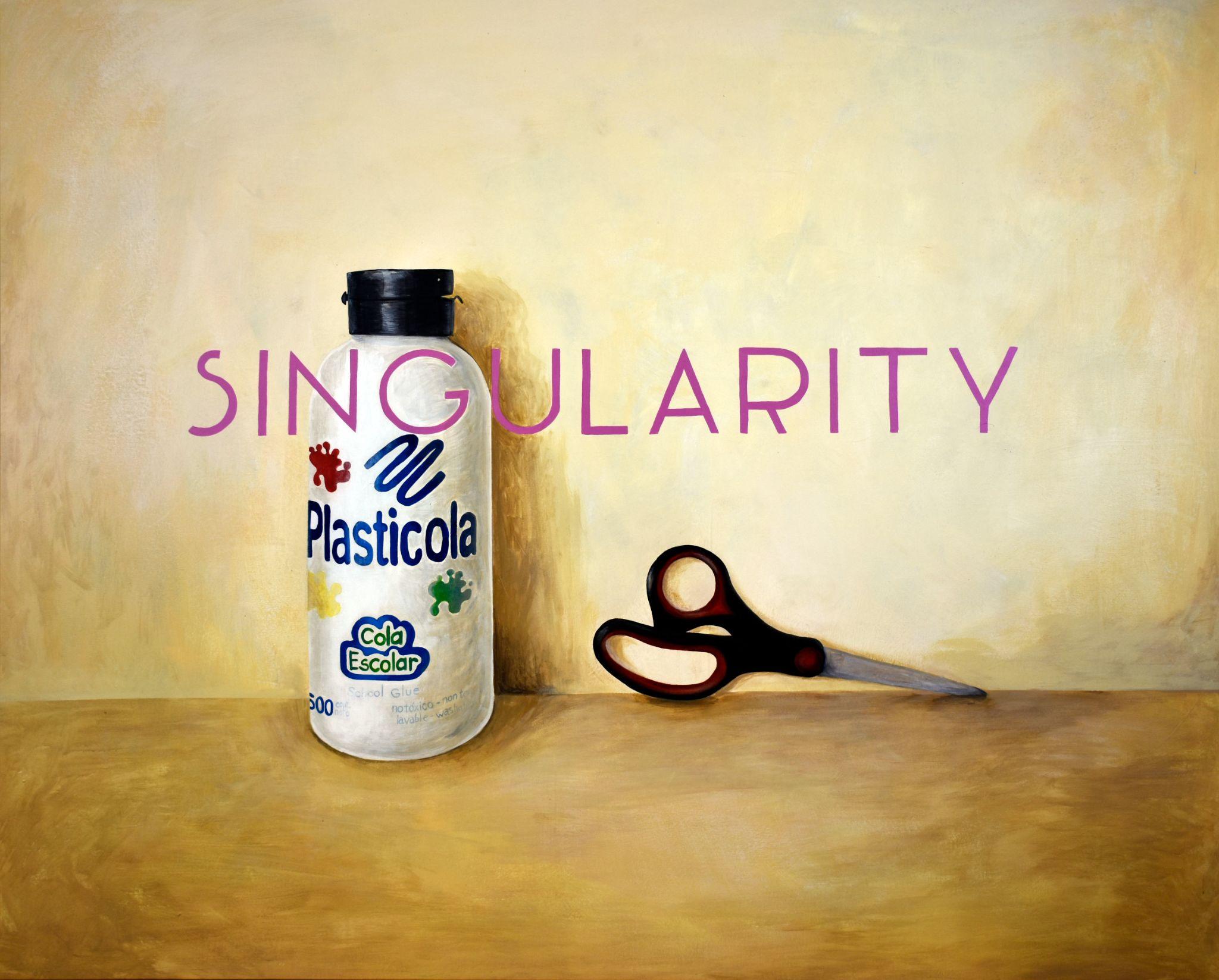Syd Krochmalny: Not a Stupid Painting


“A French saying goes—’stupid like a painter,’” Warren Neidich begins his talk on November 29, 2023 at Syd Krochmalny’s most recent solo show “Collectors Buy the Aura” at Opening Gallery. Neidich, who coined the term Wet Conceptualism, is a long-time friend of the Argentine polymath Krochmalny, and gives his soliloquy in response to Krochmalny’s work as part of an evening featuring Neidich, Reinaldo Laddaga, Associate Professor of Romance Languages at the University of Pennsylvania, and the theater director and researcher Vivi Tellas. “-Duchamp who has quoted the saying favored intelligent art over retinal art,” Neidich continues. A ‘retinal’ painter paints what is in front of them by introducing the ready-made Duchamp radically shifted from this perspective. Neidich likens the phrases Krochmalny has painted on over his imagery to Duchamp’s ready-made—while pointing out that they necessitate “an active reader that takes their subjectivity.”
The exhibition presents large-scale paintings and a couple of 3D-printed busts based on Krochmalny’s drawings that juxtapose elements from Matthew Barney, Paul McCarthy, Eneas Spilimbergo, Pablo Suárez, and Giovanni Antonio Boltraffio’s characters. The basic compositional model of each painting is that text is overlaid on an image. Most emblematic, the work “Collectors Buys the Aura” (2017) has the title of the work painted on top of an image of Claude Monet’s water lilies painted by the artist. The text is based on Walter Benjamin’s thesis that mechanical reproduction has transformed the arts, in his seminal 1936 essay “The Work of Art in the Age of Mechanical Reproduction.” Reproduction has stopped the viewer from thinking—contemplation is replaced with distraction—and this loss of authenticity leads to the loss of ‘aura,’ artworks that can be reproduced with modern technology have lost their innate spirit. But, using the example of Duchamp and calling the viewer active Neidich, and indeed the exhibition itself, dispels Benjamin’s idea that the viewer is made passive by the idea of reproduction in the mechanical age, or the digital age, for that matter.

Continuing from his Duchampian starting point and further discussing the works in an art-historical context Neidich equated the ‘ready-made phrase’ with the ready-made object referring to Jasper Johns’s work (starting from ready-made objects) and Ed Ruscha (ready-made phrase). Where Ruscha’s lettering is painted to an obsessive perfection, almost static, Krochmalny’s lines are looser and faster, nearly bursting at the seams. Neidich stands in front of a desert landscape with the text: “She leaves his body on the beach. To be cleaned up, By the Alien” an excerpt from “Orifices” a campy pop song where interspecies intimacy mirrors the inequitable relationship between men and women from the album “Language of Stones” by Krochmalny and Santos Dumont. Neidich observes the desert as public space or a mental space which also evokes multiple subcultures. Also remarking that the works are not retinal and there is “cognitive dissonance between image and text.” They cannot be understood by looking only, the reader must contextualize to understand the work which begins with the relationship between text and image.
When it is Vivi Tellas’ turn to speak she asks Krochmalny to reenact his painting process—a brilliantly entertaining ask. Tellas has taken the train from Princeton where she is a visiting scholar and is a known name in Argentinian theater. Krochmalny situates a pretend projector in front of “Collectors Buy the Aura” and starts to paint with his pretend brush on the canvas. Explaining his steps, he unmasks his artistic process and his use of technology. “The Monet I replicated is a masterpiece,” he says. Leaving the audience to decide whether his work is a masterpiece for incorporating the original masterpiece.


Navigating reproduction and referencing, common to all artistic mediums, another work depicts parts of the Terracotta Army with the text ‘SHANZAI’ overlaid, meaning fake or imitation in Chinese. It references the public scandals around fakes being on display, or nearly displayed. In 2007, Hamburg’s Museum of Ethnology offered ticket refunds to visitors who had seen them on display when it surfaced that the Leipzig exhibition company, Centre of Chinese Arts and Culture (CCAC), had sent copies to be shown. Poking fun and creating a fine line between replica and original by introducing the edition, in 2015, Chinese artist Xu Zhen, sometimes called the Maurizio Cattelan of China, who also works under his company pseudonym MadeIn exhibited the artist proof and multiple editions of his sculptures at his solo show at Long Museum in Shanghai. While Krochmalny’s “Homage and Oblivion” sculptures uses sampling to create something entirely new.

Shifting away from the re-enactment Krochmalny, who holds a PhD in Social Sciences, explains: “Traditionally, in Argentina, you have to do everything—art, music, and poetry,” he says. He has dabbled in them all, and more. “Collectors Buy the Aura” combines his work in these fields. Towards the back of the gallery an image of a ‘Plasticola’ glue bottle—a regular glue common in art schools—overlaid with the word ‘Singularity.’ In Spanish ‘cola’ also means buttocks. Serving as another entry point to originality, the work both references his time teaching in academia where students are expected to strive toward developing their own expressions while confined to a tight curriculum—an oxymoron. Overall, “Collectors Buy the Aura” introduces the audience to wide-ranging thoughts about ‘the original’ with wit and candor.
Syd Krochmalny Collectors Buy the Aura, November 9 – November 29. 2023 at The Opening Gallery, 42 Walker Street, New York.
You Might Also Like
What's Your Reaction?
Anna Mikaela Ekstrand is editor-in-chief and founder of Cultbytes. She mediates art through writing, curating, and lecturing. Her latest books are Assuming Asymmetries: Conversations on Curating Public Art Projects of the 1980s and 1990s and Curating Beyond the Mainstream. Send your inquiries, tips, and pitches to info@cultbytes.com.

